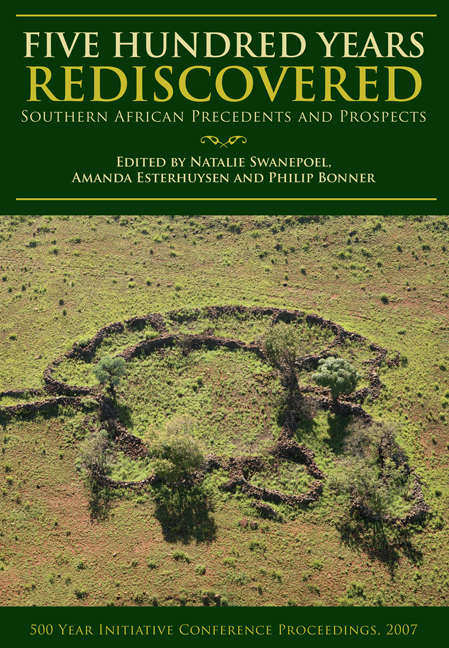Book contents
- Frontmatter
- Contents
- Preface
- 1 Introduction
- Section 1 Disciplinary Identities: Methodological Considerations
- Section 2 Material Identities
- 8 Revisiting Bokoni: populating the stone ruins of the Mpumalanga Escarpment
- 9 The Mpumalanga Escarpment settlements: some answers, many questions
- 10 Post-European contact glass beads from the southern African interior: a tentative look at trade, consumption and identities
- 11 Ceramic alliances: pottery and the history of the Kekana Ndebele in the old Transvaal
- Section 3 ‘Troubled Times’: Warfare, State Formation and Migration in the Interior
- List of contributors
- Index
11 - Ceramic alliances: pottery and the history of the Kekana Ndebele in the old Transvaal
from Section 2 - Material Identities
Published online by Cambridge University Press: 30 May 2019
- Frontmatter
- Contents
- Preface
- 1 Introduction
- Section 1 Disciplinary Identities: Methodological Considerations
- Section 2 Material Identities
- 8 Revisiting Bokoni: populating the stone ruins of the Mpumalanga Escarpment
- 9 The Mpumalanga Escarpment settlements: some answers, many questions
- 10 Post-European contact glass beads from the southern African interior: a tentative look at trade, consumption and identities
- 11 Ceramic alliances: pottery and the history of the Kekana Ndebele in the old Transvaal
- Section 3 ‘Troubled Times’: Warfare, State Formation and Migration in the Interior
- List of contributors
- Index
Summary
Introduction
In South Africa the interpretation of Iron Age ceramics has been strongly influenced by the idea that the producers and users of a pottery style are one and the same, so that style can be used to identify discrete groups of people, or the distribution of a style will mirror the distribution of the group (Huffman 1982, 1983, 2002; Evers 1988: 5). This chapter proposes a different approach to ceramics. Rather than regarding ceramic style as representative of stable cultural behaviour, it treats it as a social object. In other words the meaning and significance of a particular style of pottery will be expressed and negotiated within particular circumstances, and through a number of social encounters and exchanges (cf. Thomas 1991). This chapter lays out the complex social and political processes that defined the 19th-century political landscape, and envisages how diacritical markers, including pottery design, would have formed an integral part of this social discourse. Ceramics from Historic Cave in the Makapans Valley, studied in combination with oral and documentary histories, reveal the nature and extent of the Kekana Ndebele's political network. The context in which a particular style of pottery was found unlocks the possibility that the ceramics represented key marriage alliances forged between the Kekana and at least one section of the Kgatla.
The socio-economic landscape of the 18th and 19th centuries
During the 18th and 19th centuries the socio-economic landscape of the northern region of South Africa was characterised by shifting authority, driven by competition over resources and trade. While chiefdoms in the area had been trading with the Swahili and Portuguese on the east coast for centuries, during the latter part of the 18th century a growth in the demand for ivory in India elicited a corresponding escalation in its exports from Delagoa Bay (Eldredge 1992: 6; Manson 1995: 358). This trade, initially dominated by the English, drove competition and conflict in the region to a new level (Manson 1995: 358). To outsiders the established market made this area economically attractive. To the Trekboers and other exiles from the Cape (1820s), the prospect of taking control of the Limpopo ivory trade and setting up profitable trade relations with the Portuguese, held the promise of wealth and independence from British rule (Ferreira 2002: 50).
- Type
- Chapter
- Information
- Five Hundred Years RediscoveredSouthern African precedents and prospects, pp. 197 - 214Publisher: Wits University PressPrint publication year: 2008



